Electric Vehicles are steadily taking center stage in the world of automobiles. The demand for EVs is rising steeply, and many types of electric vehicles are already in the market.
Each type of EV has its benefits and blemishes. However, with so many options available, it can be confusing to learn about the different types and understand how they differ from each other. Well, not anymore.
In this blog, we will clear up all your confusion. We will dive deep into each EV type and tell you which one is the best.
So, read on to learn everything about the different types of electric vehicles!
Types Of Electric Vehicles
There are mainly five types of electric vehicles that differ in the way they work and if they use a combustion engine. Here is a tabular overview of these EVs:
| Type of EV | Zero Emissions | Description | Working Principle |
|---|---|---|---|
| Battery Electric Vehicles (BEVs) | ✅ | Entirely powered by a battery without an internal combustion engine (ICE). | The battery powers the motor and drives the vehicle. |
| Hybrid Electric Vehicles (HEVs) | ❌ | Powered by an ICE and a battery. | The engine drives the vehicle with help from the battery. |
| Plug-in Hybrid Electric Vehicles (PHEVs) | ❌ | Powered by an ICE and a pluggable battery. | The engine drives the vehicle with help from the battery. |
| Mild Hybrid Electric Vehicles (MHEVs) | ❌ | Powered mainly by an ICE with a battery for minor support. | The engine drives the vehicle, while the battery only powers the components. |
| Fuel Cell Electric Vehicles (FCEVs) | ✅ | Powered solely by a hydrogen fuel cell. | The fuel cell drives the vehicle while the battery assists it. |
The different types of EVs offer varying efficiency, emissions, and ease of maintenance. Now, let’s talk about these vehicles in-depth, starting with the most popular type—BEVs.
1. Battery Electric Vehicles (BEVs)
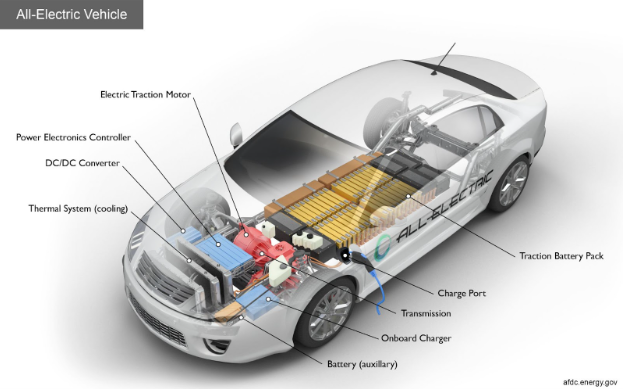
These Battery Electric Vehicles are also called “fully electric” vehicles or “all-electric” vehicles. They run solely on batteries and, unlike traditional vehicles, do not have internal combustion engines.
Since no combustion is involved, BEVs produce zero tailpipe emissions and are considered the most eco-friendly vehicles. The battery can be charged using an external electric source at home or a charging station.
Once fully charged, most four-wheeler BEVs offer a range of 100-400 kilometers or more, depending on the battery capacity. They are usually more pricey than comparable ICE vehicles, hybrids, and plug-in hybrids, but they cost much less to charge and maintain.
How BEVs work:
A BEV contains a rechargeable battery pack, one or more electric motors, an inverter, a control unit, a drive train, and other components.
The battery generates power, which the inverter converts into AC voltage before sending it to the electric motor. The control unit is responsible for maintaining speed and acceleration, among other things.
When brakes are applied, the motor decelerates and acts as a generator, sending some energy back to the battery. This braking mechanism, called regenerative braking, charges the battery while driving and improves the vehicle’s overall efficiency.
BEV Examples:
- Tata Nexon EV
- Tata Tiago EV
- Hyundai Kona Electric
- Mahindra XUV400
- MG ZS EV
2. Hybrid Electric Vehicles (HEVs)
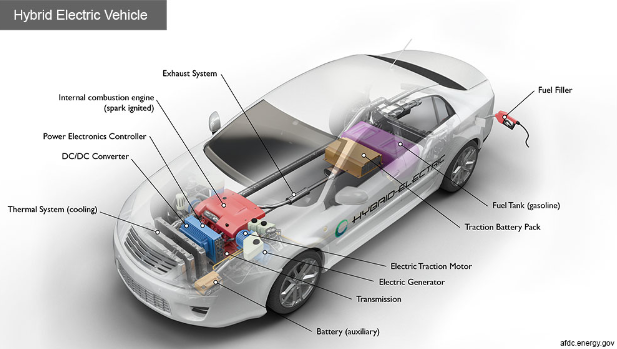
Hybrid Electric Vehicles (HEVs) combine the benefits of BEVs and traditional vehicles as they contain both a combustion engine and a battery pack.
The battery capacity is much less in HEVs since the battery only assists the engine in running the vehicle. You need to top up the vehicle with traditional fuels like petrol and diesel. However, HEVs can also travel short distances solely on battery.
Thanks to the battery, these vehicles produce less emissions than comparable ICE vehicles and offer greater mileage with the same amount of fuel. Hybrids are cheaper than BEVs and require somewhat less maintenance than ICE vehicles.
How HEVs work
An HEV contains a traditional ICE-based set up along with the core components of a BEV. The engine is the primary power source, while the battery and electric motor provide additional power.
The battery can improve the engine’s performance when the vehicle accelerates from zero or travels at low speeds. Hybrid vehicles can have a series, parallel, or series-parallel setup depending on if and how the engine and motor work simultaneously.
Unlike BEVs, HEVs cannot be plugged into an external power source. The battery is only charged via regenerative braking and the power from the engine.
HEV Examples:
- Toyota Prius
- Maruti Suzuki NEXA XL6
- Honda City e:HEV
- MG Hector Smart Hybrid
- Hyundai IONIQ Hybrid
3. Plug-in Hybrid Electric Vehicles (PHEVs)
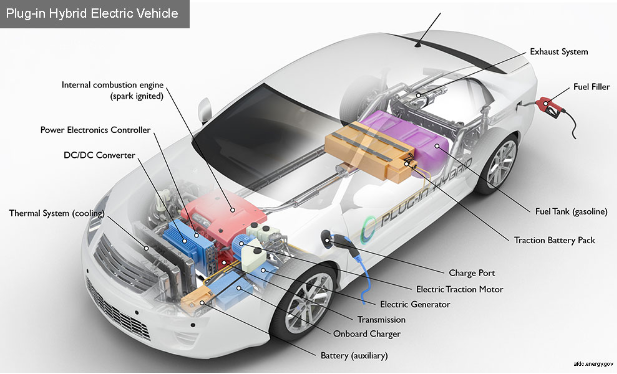
Like hybrid vehicles, Plug-in Hybrid Electric Vehicles have a combustion engine and a battery pack. But there’s a twist—they can be plugged into a power source to charge the battery.
The battery and electric motor in PHEVs are more powerful than those in HEVs. These vehicles can run solely on battery for short distances, usually 15-80 km, and can also use the engine and battery together like the usual hybrid.
Since PHEVs can run on all-electric mode for most daily commutes, they cause much lower CO2 emissions than non-plugin hybrids (HEVs). They usually cost more than HEVs but less than BEVs. However, they are more fuel-efficient than hybrids.
How PHEVs work:
The main components of a plugin hybrid are the same as those of a usual HEV, but the way these components work is noticeably different.
A PHEV generally starts with an all-electric mode. Once the battery dies, the engine kicks in, running the vehicle like a usual hybrid. It can switch between the engine and battery, depending on driving conditions.
While plugging in is important to charge the battery fully, power from the engine and regenerative braking also partially charge the battery while driving.
PHEV Examples:
- Hyundai IONIQ Plug-in Hybrid
- Volvo XC90 Recharge
- Volkswagen Golf GTE
- Toyota RAV4 Prime
- BMW 330e
4. Mild Hybrid Electric Vehicles (MHEVs)
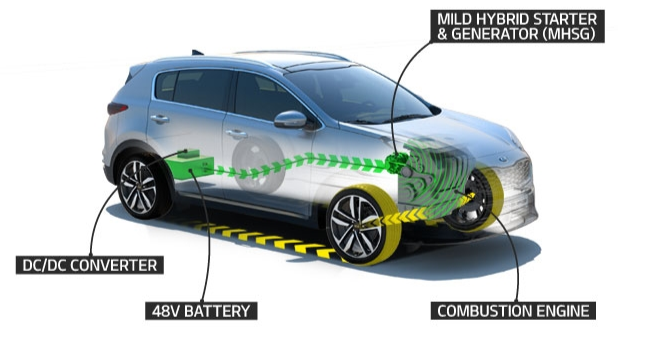
Mild Hybrid Vehicles get most of their power from an internal combustion engine. Like hybrid vehicles, they also rely on a battery pack and electric motor to assist the engine.
However, the small battery and motor in MHEVs cannot drive and accelerate the vehicle on their own. Rather, they only help start the vehicle and power its auxiliary components—such as headlights and AC—as the vehicle runs on fuel.
Mild hybrids are not as efficient as hybrids or plug-in hybrids and, hence, cost less on average. They produce less emissions than ICE vehicles but more than hybrids and plug-in hybrids.
How MHEVs work:
A mild hybrid vehicle contains a typical ICE setup along with a small, 48-volt battery and starter motor, which is also called an integrated starter generator (ISG). The electric system helps power the vehicle and lets the engine shut off when the vehicle stops.
As in a regular non-plugin hybrid, the battery gets charged via regenerative braking and engine power. The vehicle cannot be plugged into an external power source.
MHEV Examples:
- Hyundai Tucson 48-volt
- Chevrolet Silverado LD
- 2016 Suzuki Baleno SZ-T
5. Fuel Cell Electric Vehicles (FCEVs)
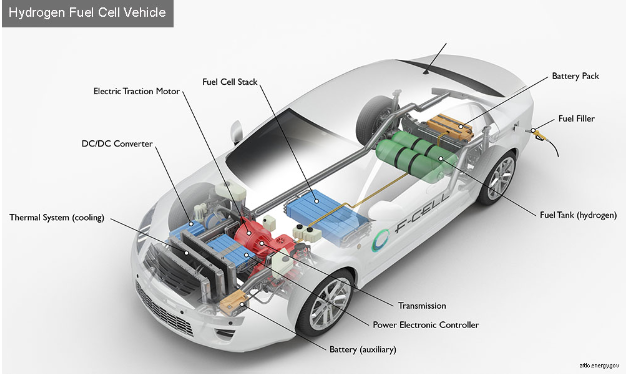
FCEVs are similar to BEVs, as they also run solely on electricity and don’t have a combustion engine. However, they get their power mostly from a fuel cell and not from a battery pack.
Most fuel cell EVs use hydrogen as fuel. There is also a battery pack, but its only role is to support the fuel cell by providing additional power during certain conditions. These vehicles can easily offer a range of 300-400 miles or more per refuel.
Like all-electric vehicles, FCEVs produce zero emissions, with the only byproduct being water vapor. However, there is currently not enough infrastructure for fuel cells and hydrogen fuels in general, which makes it difficult to own and maintain these vehicles.
How FCEVs work:
A typical FCEV contains a fuel tank, fuel cell stack, battery pack, one or more electric motors, inverter, and control module, among other things. The fuel cell is the main power source.
A chemical reaction between hydrogen and air (oxygen) in the fuel cell generates electrical energy, which powers the electric motor. The fuel cell also charges the battery pack, which assists the motors and improves the overall vehicle efficiency.
Regenerative braking also recharges the battery, while the fuel cell can be topped up with compressed hydrogen within a few minutes.
FCEV Examples:
- Toyota Mirai
- Hyundai Nexo
- BMW iX5
- Land Rover Defender
What Type Of Electric Vehicle Is The Best?
Knowing about the types of electric vehicles is one thing. But how do you choose which one is the best?
The answer is very subjective, as each type of EV has its unique set of features and shortcomings that may or may not work for you.
Here are five factors you can consider to weigh these pros and cons and find the type that’s best for your needs.
1. Affordability
BEVs and FCEVs are the most eco-friendly EV types. But they also cost the most. They can be the best option if the price comes under your budget. If it doesn’t, going for more economical options such as hybrids or plug-in hybrids might be a better idea.
2. Mileage
How long the EV can run on a single charge/refill can determine its overall efficiency. Since BEVs are charged using electricity, they don’t cost much to drive. However, hybrids can cost much more for the same mileage since they need fuels, which are costly.
3. Infrastructure
A proper infrastructure is just as important as affordability and great range. If your region doesn’t have a wide range of charging networks, charging your BEV may get difficult. Similarly, FCEVs are not preferred in most regions because there are not enough hydrogen refilling stations around.
4. Environmental Impact
While all EVs produce less emissions than conventional vehicles, not all of them produce zero emissions. If you want zero emissions, you can go for a BEV or FCEV. If you rather want the benefits of conventional vehicles with less emissions, go for hybrids.
5. Maintenance
The maintenance needs of EVs vary across types. EVs that don’t have a combustion engine, i.e., BEVs and FCEVs, cost much less to maintain. However, hybrids require more maintenance as they also have an engine.
Depending on what your priorities for owning an EV are, you can choose your preferred type of EV by weighing the above factors per your needs.
Future of Electric Vehicles in India
India’s journey towards electrifying its transportation system holds significant promise for environmental sustainability and economic growth. The government’s push for cleaner mobility through incentives, subsidies, and favorable policies is accelerating EV adoption.
With targets like achieving 30% electric vehicle penetration by 2030, the Indian market is ripe for transformation. Investments in EV infrastructure, such as charging stations and advancements in battery technology, are crucial to overcoming current limitations and ensuring widespread EV use.
Moreover, the entry of major automobile manufacturers into the EV space, coupled with innovative startups, is fostering competition and innovation. This dynamic landscape is expected to drive down costs, improve vehicle performance, and expand the variety of available models.
Related Read:
Conclusion: There Are 5 Types Of Electric Vehicles!
Since every type of EV has a unique set of components that work uniquely together, the EVs perform differently on various parameters.
BEVs and FCEVs produce zero emissions and are, hence, the most eco-friendly vehicles. Hybrids blend the benefits of conventional and electric vehicles, providing the best of both worlds. However, FCEVs don’t have a proper infrastructure, and hybrids require more maintenance.
Nevertheless, as the charging infrastructure and support networks of EVs continue to expand, EVs are set to be the sustainable future of automobiles. So, go ahead and make an informed decision on the best type of EV for you!